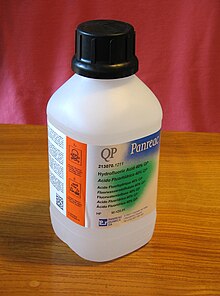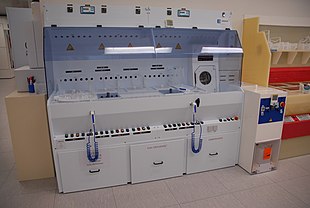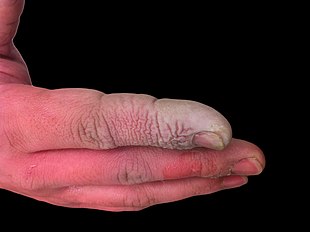Hf Acid Weak Or Strong
 | |||
| |||
| |||
| Names | |||
|---|---|---|---|
| IUPAC proper noun Fluorane[one] | |||
| Other names Fluorhydric acid | |||
| Identifiers | |||
| CAS Number |
| ||
| 3D model (JSmol) |
| ||
| ChEBI |
| ||
| ChemSpider |
| ||
| EC Number |
| ||
| PubChem CID |
| ||
| RTECS number |
| ||
| UNII |
| ||
| CompTox Dashboard (EPA) |
| ||
| InChI
| |||
| SMILES
| |||
| Properties | |||
| Chemical formula | HF (aq) | ||
| Appearance | Colorless liquid | ||
| Density | 1.15 m/mL (for 48% soln.) | ||
| Acidity (pThousand a) | 3.17[2] | ||
| Hazards[three] | |||
| GHS labelling: | |||
| Pictograms |   | ||
| Signal word | Danger | ||
| Hazard statements | H280, H300, H310, H314, H330 | ||
| Precautionary statements | P260, P262, P264, P270, P271, P280, P284, P301+P310, P301+P330+P331, P302+P350, P303+P361+P353, P304+P340, P305+P351+P338, P310, P320, P321, P322, P330, P361, P363, P403+P233, P405, P410+P403, P501 | ||
| NFPA 704 (burn diamond) | 4 0 0 ACID | ||
| Except where otherwise noted, information are given for materials in their standard state (at 25 °C [77 °F], 100 kPa). Infobox references | |||
Hydrofluoric acid is a solution of hydrogen fluoride (HF) in h2o. Solutions of HF are colourless, acidic and highly corrosive. It is used to brand most fluorine-containing compounds; examples include the commonly used pharmaceutical antidepressant medication fluoxetine (Prozac) and the cloth PTFE (Teflon). Elemental fluorine is produced from information technology. It is commonly used to etch drinking glass and silicon wafers.
Uses [edit]
Production of organofluorine compounds [edit]
The chief use of hydrofluoric acrid is in organofluorine chemistry. Many organofluorine compounds are prepared using HF every bit the fluorine source, including Teflon, fluoropolymers, fluorocarbons, and refrigerants such every bit freon. Many pharmaceuticals contain fluorine.[iv]
Production of inorganic fluorides [edit]
Most loftier-volume inorganic fluoride compounds are prepared from hydrofluoric acid. Foremost are NaiiiAlF6, cryolite, and AlF3, aluminium trifluoride. A molten mixture of these solids serves as a high-temperature solvent for the production of metallic aluminium. Other inorganic fluorides prepared from hydrofluoric acid include sodium fluoride and uranium hexafluoride.[four]
Etchant, cleaner [edit]

It is used in the semiconductor industry equally a major component of Wright Etch and buffered oxide etch, which are used to clean silicon wafers. In a similar manner it is besides used to etch drinking glass by treatment with silicon dioxide to grade gaseous or water-soluble silicon fluorides. It can too be used to polish and frost glass.[v]
- SiOtwo + iv HF → SiF4(thou) + 2 HiiO
- SiOtwo + 6 HF → H2SiFhalf dozen + 2 H2O
A 5% to nine% hydrofluoric acid gel is also commonly used to etch all ceramic dental restorations to improve bonding.[6] For similar reasons, dilute hydrofluoric acrid is a component of household rust stain remover, in automobile washes in "wheel cleaner" compounds, in ceramic and material rust inhibitors, and in water spot removers.[five] [7] Because of its ability to deliquesce iron oxides as well every bit silica-based contaminants, hydrofluoric acid is used in pre-commissioning boilers that produce high-pressure steam. Hydrofluoric acid is also useful for dissolving rock samples (normally powdered) prior to analysis. In like manner, this acid is used in acid macerations to extract organic fossils from silicate rocks. Fossiliferous rock may be immersed direct into the acrid, or a cellulose nitrate film may exist applied (dissolved in amyl acetate), which adheres to the organic component and allows the rock to be dissolved around it.[viii]
Oil refining [edit]
In a standard oil refinery process known equally alkylation, isobutane is alkylated with low-molecular-weight alkenes (primarily a mixture of propylene and butylene) in the presence of an acid goad derived from hydrofluoric acid. The catalyst protonates the alkenes (propylene, butylene) to produce reactive carbocations, which alkylate isobutane. The reaction is carried out at mild temperatures (0 and 30 °C) in a two-phase reaction.
Production [edit]
Hydrofluoric acid was first prepared in 1771, by Carl Wilhelm Scheele.[ix] Information technology is now mainly produced by treatment of the mineral fluorite, CaF2, with full-bodied sulfuric acid at approximately 265 °C.
- CaF2 + HiiSO4 → 2 HF + CaSOfour
The acrid is besides a by-product of the product of phosphoric acrid from apatite and fluoroapatite. Digestion of the mineral with sulfuric acid at elevated temperatures releases a mixture of gases, including hydrogen fluoride, which may be recovered.[4]
Because of its high reactivity toward drinking glass, hydrofluoric acrid is stored in fluorinated plastic (often PTFE) containers.[four] [5]
Backdrop [edit]
In dilute aqueous solution hydrogen fluoride behaves as a weak acrid,[ten] Infrared spectroscopy has been used to show that, in solution, dissociation is accompanied by formation of the ion pair HthreeO+ ·F−.[eleven] [12]
- H2O + HF ⇌ HiiiO+ ⋅F− pM a = three.17
This ion pair has been characterized in the crystalline state at very depression temperature.[13] Farther association has been characterized both in solution and in the solid country.[ citation needed ]
- HF + F− ⇌ HF −
ii log M = 0.half dozen
It is assumed that polymerization occurs equally the concentration increases. This supposition is supported past the isolation of a salt of a tetrameric anion H
3 F −
4 [14] and by low-temperature X-ray crystallography.[13] The species that are present in concentrated aqueous solutions of hydrogen fluoride have non all been characterized; in addition to HF −
2 which is known[11] the germination of other polymeric species, H
north−1 F −
n , is highly likely.
The Hammett acidity function, H 0, for 100% HF is estimated to exist betwixt −ten.2 and −11,[15] which is comparable to the value −12 for sulfuric acid.[16] [17]
Acidity [edit]
Unlike other hydrohalic acids, such as hydrochloric acid, hydrogen fluoride is only a weak acrid in dilute aqueous solution.[18] This is in part a result of the forcefulness of the hydrogen–fluorine bail, simply also of other factors such equally the tendency of HF, H
ii O, and F −
anions to class clusters.[19] At high concentrations, HF molecules undergo homoassociation to course polyatomic ions (such as bifluoride, HF −
2 ) and protons, thus greatly increasing the acerbity.[20] This leads to protonation of very strong acids like hydrochloric, sulfuric, or nitric when using concentrated hydrofluoric acid solutions.[21] Although hydrofluoric acid is regarded every bit a weak acrid, it is very corrosive, even attacking glass when hydrated.[xx]
The acidity of hydrofluoric acrid solutions varies with concentration owing to hydrogen-bond interactions of the fluoride ion. Dilute solutions are weakly acidic with an acid ionization abiding K a = 6.6×x−4 (or pK a = 3.18),[10] in contrast to respective solutions of the other hydrogen halides, which are strong acids (pThou a < 0). Full-bodied solutions of hydrogen fluoride are much more strongly acidic than implied by this value, every bit shown by measurements of the Hammett acerbity part H 0 [fifteen](or "effective pH"). The H 0 for 100% HF is estimated to be between −10.ii and −11, comparable to the value −12 for sulfuric acid.[sixteen] [17]
In thermodynamic terms, HF solutions are highly not-ideal, with the activity of HF increasing much more than rapidly than its concentration. The weak acerbity in dilute solution is sometimes attributed to the high H—F bond strength, which combines with the high dissolution enthalpy of HF to outweigh the more negative enthalpy of hydration of the fluoride ion.[22] Paul Giguère and Sylvia Turrell[11] [12] have shown by infrared spectroscopy that the predominant solute species in dilute solution is the hydrogen-bonded ion pair HthreeO+ ·F−.[23]
- H2O + HF ⇌ H3O+ ⋅F−
With increasing concentration of HF the concentration of the hydrogen difluoride ion also increases.[11] The reaction
- 3 HF ⇌ HF −
2 + HtwoF+
is an example of homoconjugation.
Health and safety [edit]

A hydrofluoric acid burn of the paw
In addition to being a highly corrosive liquid, hydrofluoric acid is too a powerful contact poison. Because of the ability of hydrofluoric acid to penetrate tissue, poisoning can occur readily through exposure of skin or eyes, or when inhaled or swallowed. Symptoms of exposure to hydrofluoric acrid may not exist immediately evident, and this can provide faux reassurance to victims, causing them to delay medical treatment.[24] Despite having an irritating odour, HF may achieve dangerous levels without an obvious odor.[5] HF interferes with nerve function, meaning that burns may not initially exist painful. Accidental exposures tin go unnoticed, delaying treatment and increasing the extent and seriousness of the injury.[24] Symptoms of HF exposure include irritation of the eyes, skin, nose, and throat, eye and skin burns, rhinitis, bronchitis, pulmonary edema (fluid buildup in the lungs), and bone damage.[25]
In the event of a hydrofluoric fire, information technology is recommended to launder with enough of "Laboratory Kit" water, non running water, and treat as a first measure with a calcium gluconate gel (which must be available in all places where there is or is handle this substance). Declining that, use a solution of calcium lactate or calcium citrate or, failing that also, with milk. It also must be considered a medical emergency in case of aspiration of vapours. In this case, it must be treated past applying oxygen through a mask (other materials are discouraged due to irritants) if the afflicted person breathes, controlling their level of consciousness. If necessary, resuscitation of the affected person should be practical. In case of splashes in the eyes, only treat with a very abundant sterile physiological solution; like in the breathing case, substances based on calcium compounds are discouraged due to their irritating properties.
An element that has been very useful to avoid the agin effects of chemical burns and counteract the effect of calcium precipitation is the Hexafluorine solution,[26] which is recommended to implement in laboratory kits, forth with first aid items and emergency showers.
In absolutely all cases, it should be treated in an avant-garde medical manner after first aid has been rendered.
Encounter as well [edit]
- Vapour phase decomposition
References [edit]
- ^ Favre, Henri A.; Powell, Warren H., eds. (2014). Nomenclature of Organic Chemistry: IUPAC Recommendations and Preferred Names 2013. Cambridge: The Royal Society of Chemistry. p. 131. ISBN9781849733069.
- ^ Harris, Daniel C. (2010). Quantitative Chemical Assay (eighth international ed.). New York: W. H. Freeman. pp. AP14. ISBN978-1429263092.
- ^ "Hydrofluoric Acid". PubChem. National Plant of Health. Retrieved October 12, 2017.
- ^ a b c d Aigueperse, Jean; Mollard, Paul; Devilliers, Didier; Chemla, Marius; Faron, Robert; Romano, René; Cuer, Jean Pierre (2000). "Fluorine Compounds, Inorganic". Ullmann's Encyclopedia of Industrial Chemical science. Weinheim: Wiley-VCH. doi:10.1002/14356007.a11_307.
- ^ a b c d "CDC – The Emergency Response Safe and Health Database: Systemic Amanuensis: HYDROGEN FLUORIDE/ HYDROFLUORIC Acid – NIOSH". www.cdc.gov . Retrieved 2015-12-04 .
- ^ Craig, Robert (2006). Craig'south restorative dental materials. St. Louis, Mo: Mosby Elsevier. ISBN0-323-03606-half dozen. OCLC 68207297.
- ^ Strachan, John (January 1999). "A deadly rinse: The dangers of hydrofluoric acid". Professional Carwashing & Detailing. 23 (1). Archived from the original on Apr 25, 2012.
- ^ Edwards, D. (1982). "Bitty non-vascular constitute microfossils from the tardily Silurian of Wales". Botanical Journal of the Linnean Society. 84 (three): 223–256. doi:10.1111/j.1095-8339.1982.tb00536.x.
- ^ Greenwood, Norman Northward.; Earnshaw, Alan (1984). Chemical science of the Elements. Oxford: Pergamon Press. p. 921. ISBN978-0-08-022057-4.
- ^ a b Ralph H. Petrucci; William Due south. Harwood; Jeffry D. Madura (2007). General chemical science: principles and modern applications. Pearson/Prentice Hall. p. 691. ISBN978-0-13-149330-8 . Retrieved 22 Baronial 2011.
- ^ a b c d Giguère, Paul A.; Turrell, Sylvia (1980). "The nature of hydrofluoric acrid. A spectroscopic written report of the proton-transfer complex HthreeO+...F−". J. Am. Chem. Soc. 102 (17): 5473. doi:10.1021/ja00537a008.
- ^ a b Radu Iftimie; Vibin Thomas; Sylvain Plessis; Patrick Marchand; Patrick Ayotte (2008). "Spectral Signatures and Molecular Origin of Acid Dissociation Intermediates". J. Am. Chem. Soc. 130 (eighteen): 5901–7. doi:10.1021/ja077846o. PMID 18386892.
- ^ a b Mootz, D. (1981). "Crystallochemical Correlate to the Anomaly of Hydrofluoric Acrid". Angew. Chem. Int. Ed. Engl. 20 (123): 791. doi:10.1002/anie.198107911.
- ^ Bunič, Tina; Tramšek, Melita; Goreshnik, Evgeny; Žemva, Boris (2006). "Barium trihydrogen tetrafluoride of the limerick Ba(HthreeFiv)two: The outset example of homoleptic HF metal environment". Solid Country Sciences. 8 (viii): 927–931. Bibcode:2006SSSci...eight..927B. doi:10.1016/j.solidstatesciences.2006.02.045.
- ^ a b Hyman, Herbert H.; Kilpatrick, Martin; Katz, Joseph J. (1957). "The Hammett Acidity Function H 0 for Hydrofluoric Acrid Solutions". Periodical of the American Chemic Guild. American Chemical Society (ACS). 79 (fourteen): 3668–3671. doi:10.1021/ja01571a016. ISSN 0002-7863.
- ^ a b Jolly, William L. (1991). Modern Inorganic Chemistry. McGraw-Hill. p. 203. ISBN0-07-032768-8. OCLC 22861992.
- ^ a b Cotton wool, F. A.; Wilkinson, Thou. (1988). Advanced Inorganic Chemistry (5th ed.). New York: Wiley. p. 109. ISBN0-471-84997-nine. OCLC 16580057.
- ^ Wiberg, Egon; Wiberg, Nils; Holleman, Arnold Frederick (2001). Inorganic Chemistry. San Diego: Academic Printing. p. 425. ISBN978-0-12-352651-nine.
- ^ Clark, Jim (2002). "The acidity of the hydrogen halides". Retrieved iv September 2011.
- ^ a b Chambers, C.; Holliday, A. Chiliad. (1975). Modern inorganic chemistry (An intermediate text) (PDF). The Butterworth Group. pp. 328–329. Archived from the original (PDF) on 2013-03-23.
- ^ Hannan, Henry J. (2010). Form in chemistry for IIT-JEE 2011. Tata McGraw Hill Education Private Limited. pp. xv–22. ISBN9780070703360.
- ^ C. E. Housecroft and A. Yard. Sharpe "Inorganic Chemistry" (Pearson Prentice Hall, 2nd ed. 2005), p. 170.
- ^ Cotton & Wilkinson (1988), p. 104
- ^ a b Yamashita M, Yamashita M, Suzuki M, Hirai H, Kajigaya H (2001). "Ionophoretic delivery of calcium for experimental hydrofluoric acid burns". Crit. Care Med. 29 (viii): 1575–8. doi:10.1097/00003246-200108000-00013. PMID 11505130. S2CID 45595073.
- ^ "CDC – NIOSH Pocket Guide to Chemical Hazards – Hydrogen fluoride". www.cdc.gov . Retrieved 2015-11-28 .
- ^ "The HEXAFLUORINE® solution - PREVOR". Prevor EN . Retrieved 2022-08-18 .
External links [edit]
- International Chemical Rubber Card 0283
- NIOSH Pocket Guide to Chemical Hazards
- CID 14917 from PubChem (HF)
- CID 144681 from PubChem (5HF)
- CID 141165 from PubChem (6HF)
- CID 144682 from PubChem (7HF)
- "Hydrofluoric Acid Fire", The New England Periodical of Medicine—Acid burn down case report
Hf Acid Weak Or Strong,
Source: https://en.wikipedia.org/wiki/Hydrofluoric_acid
Posted by: bakerboser1959.blogspot.com







0 Response to "Hf Acid Weak Or Strong"
Post a Comment